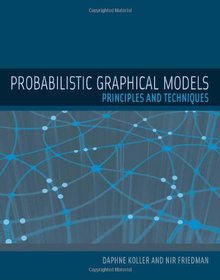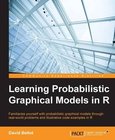Probabilistic Graphical Models
Principles and Techniques

Book Details:
| Publisher: | MIT Press |
| Series: | MIT Press , Principles |
| Author: | Daphne Koller |
| Edition: | 1 |
| ISBN-10: | 0262013193 |
| ISBN-13: | 9780262013192 |
| Pages: | 1208 |
| Published: | Nov 16 2009 |
| Posted: | May 23 2017 |
| Language: | English |
| Book format: | |
| Book size: | 8.05 MB |
Book Description:
Most tasks require a person or an automated system to reason -- to reach conclusions based on available information. The framework of probabilistic graphical models, presented in this book, provides a general approach for this task. The approach is model-based, allowing interpretable models to be constructed and then manipulated by reasoning algorithms. These models can also be learned automatically from data, allowing the approach to be used in cases where manually constructing a model is difficult or even impossible. Because uncertainty is an inescapable aspect of most real-world applications, the book focuses on probabilistic models, which make the uncertainty explicit and provide models that are more faithful to reality. Probabilistic Graphical Models discusses a variety of models, spanning Bayesian networks, undirected Markov networks, discrete and continuous models, and extensions to deal with dynamical systems and relational data. For each class of models, the text describes the three fundamental cornerstones: representation, inference, and learning, presenting both basic concepts and advanced techniques. Finally, the book considers the use of the proposed framework for causal reasoning and decision making under uncertainty. The main text in each chapter provides the detailed technical development of the key ideas. Most chapters also include boxes with additional material: skill boxes, which describe techniques; case study boxes, which discuss empirical cases related to the approach described in the text, including applications in computer vision, robotics, natural language understanding, and computational biology; and concept boxes, which present significant concepts drawn from the material in the chapter. Instructors (and readers) can group chapters in various combinations, from core topics to more technically advanced material, to suit their particular needs.
Download Link:
Related Books:
Building Probabilistic Graphical Models with Python
Solve machine learning problems using probabilistic graphical models implemented in Python with real-world applications Overview Stretch the limits of machine learning by learning how graphical models provide an insight on particular problems, especially in high dimension areas such as image processing and NLP Solve real-world problems using Python libraries to run inferences using graphical models A practical, step-by-step guide that introduces readers to representation, inference, and learning using Python libraries best suited to each task In Detail With the increasing prominence in machine learning and data science applications, probabilistic graphical models are a new tool that machine learning users can use to discover and analyze structures ...
Learning Probabilistic Graphical Models in R
Familiarize yourself with probabilistic graphical models through real-world problems and illustrative code examples in R About This Book * Predict and use a probabilistic graphical models (PGM) as an expert system * Comprehend how your computer can learn Bayesian modeling to solve real-world problems * Know how to prepare data and feed the models by using the appropriate algorithms from the appropriate R package Who This Book Is For This book is for anyone who has to deal with lots of data and draw conclusions from it, especially when the data is noisy or uncertain. Data scientists, machine learning enthusiasts, engineers, and those who curious about the latest advances in machine learning will find PGM interesting. What You Will Learn * Underst...
Safety Instrumented Systems Verification
Practical Probabilistic Calculation
This book clearly explains how to do probabilistic calculations to accomplish SIL verification for safety systems. Starting with a description of the safety lifecycle, the authors show where and how SIL verification fits into the key activities from conceptual design through commissioning. The book not only explains the theory and methods for doing the calculations, the authors also provide many examples from the chemical, petrochemical, power and oil & gas industries. Through numerous examples, the authors make the material understandable, plus the data tables give readers important information needed to do the verification calculations. The authors provide example failure rate data and other important metrics needed for probabilistic calculatio...
2007 - 2021 © eBooks-IT.org



